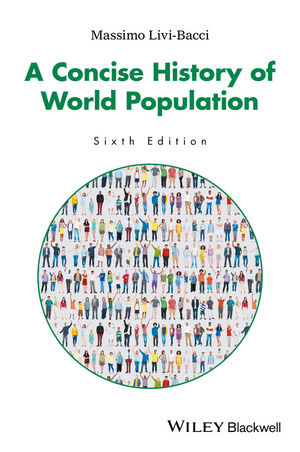
A Concise History of World Population
Wiley-Blackwell (Verlag)
978-1-119-02927-4 (ISBN)
A new edition of this classic history of demography text, which has been updated to strengthen the major subject areas of Africa, international migration and population and the environment
Includes the latest statistical information, including the 2015 UN population projections revision and developments in China's population policy
Information is presented in a clear and simple form, with academic material presented accessibly for the undergraduate audience whilst still maintaining the interest of higher level students and scholars
The text covers issues that are crucial to the future of every species by encouraging humanity's search for ways to prevent future demographic catastrophes brought about by environmental or human agency
Analyses the changing patterns of world population growth, including the effects of migration, war, disease, technology and culture
Massimo Livi-Bacci is Professor of Demography at the University of Florence. A former president of the International Union for the Scientific Study of Population, his extensive research interests include contemporary demography as well as the history of population. He has taught and held fellowships at universities all over the world, including Princeton University, the University of California at Berkeley, the Collège de France, and the Colegio de México. His many publications include Population and Nutrition (1991), The Population of Europe: A History (Blackwell, 1999), Conquest: The Destruction of the American Indios (2007), and A Short History of Migration (2012).
Preface ix
Acknowledgment xi
1 The Space and Strategy of Demographic Growth 1
1.1 Humans and Animals 1
1.2 Divide and Multiply 5
1.3 Jacopo Bichi and Domenica Del Buono, Jean Guyon, and Mathurine Robin 7
1.4 Reproduction and Survival 9
1.5 The Space of Growth 17
1.6 Environmental Constraints 19
1.7 A Few Figures 24
Notes 27
Further Reading 32
2 Demographic Growth: Between Choice and Constraint 33
2.1 Constraint, Choice, Adaptation 33
2.2 From Hunters to Farmers: The Neolithic Demographic Transition 35
2.3 Black Death and Demographic Decline in Europe 42
2.4 The Tragedy of the American Indios: Old Microbes and New Populations 47
2.5 Africa, America, and the Slave Trade 53
2.6 The French Canadians: A Demographic Success Story 57
2.7 Ireland and Japan: Two Islands, Two Histories 61
2.8 On the Threshold of the Contemporary World: China and Europe 67
Notes 73
Further Reading 84
3 Land, Labor, and Population 85
3.1 Diminishing Returns and Demographic Growth 85
3.2 Historical Confirmations 89
3.3 Demographic Pressure and Economic Development 94
3.4 More on Demographic Pressure and Development: Examples from the Stone Age to the Present Day 98
3.5 Space, Land, and Development 101
3.6 Population Size and Prosperity 108
3.7 Increasing or Decreasing Returns? 112
Notes 113
Further Reading 117
4 Toward Order and Efficiency: The Recent Demography of Europe and the Developed World 119
4.1 From Waste to Economy 119
4.2 From Disorder to Order: The Lengthening of Life 124
4.3 From High to Low Fertility 131
4.4 European Emigration: A Unique Phenomenon 137
4.5 A Summing Up: The Results of the Transition 143
4.6 Theoretical Considerations on the Relationship between Demographic and Economic Growth 146
4.7 More on the Relationship between Demographic and Economic Growth: Empirical Observations 150
Notes 157
Further Reading 164
5 The Populations of Poor Countries 167
5.1 An Extraordinary Phase 167
5.2 The Conditions of Survival 172
5.3 A Brief Geography of Fertility 179
5.4 The Conditions and Prospects for Fertility Decline and Demographic Policy 184
5.5 India and China 191
5.6 Fertilia and Sterilia 201
5.7 Explaining a Paradox 205
Notes 212
Further Reading 222
6 The Future 225
6.1 Population and Self‐Regulation 225
6.2 The Numbers of the Future 227
6.3 The North–South Divide and International Migration 233
6.4 On Sustainability of Extended Survival 242
6.5 The Moving Limits 251
6.6 Non‐Renewable Resources and the Parable of Pauperia and Tycoonia 255
6.7 Food for All? 259
6.8 Space and Environment in a Smaller Planet 265
6.9 Calculations and Values 270
Notes 274
Major Scientific Journals for Further Reading 281
Index 283
| Erscheinungsdatum | 04.03.2017 |
|---|---|
| Verlagsort | Hoboken |
| Sprache | englisch |
| Maße | 150 x 229 mm |
| Gewicht | 386 g |
| Themenwelt | Geisteswissenschaften ► Geschichte ► Allgemeine Geschichte |
| Geschichte ► Teilgebiete der Geschichte ► Kulturgeschichte | |
| Naturwissenschaften ► Geowissenschaften ► Geografie / Kartografie | |
| Sozialwissenschaften ► Politik / Verwaltung | |
| Sozialwissenschaften ► Soziologie ► Empirische Sozialforschung | |
| ISBN-10 | 1-119-02927-9 / 1119029279 |
| ISBN-13 | 978-1-119-02927-4 / 9781119029274 |
| Zustand | Neuware |
| Haben Sie eine Frage zum Produkt? |
aus dem Bereich


